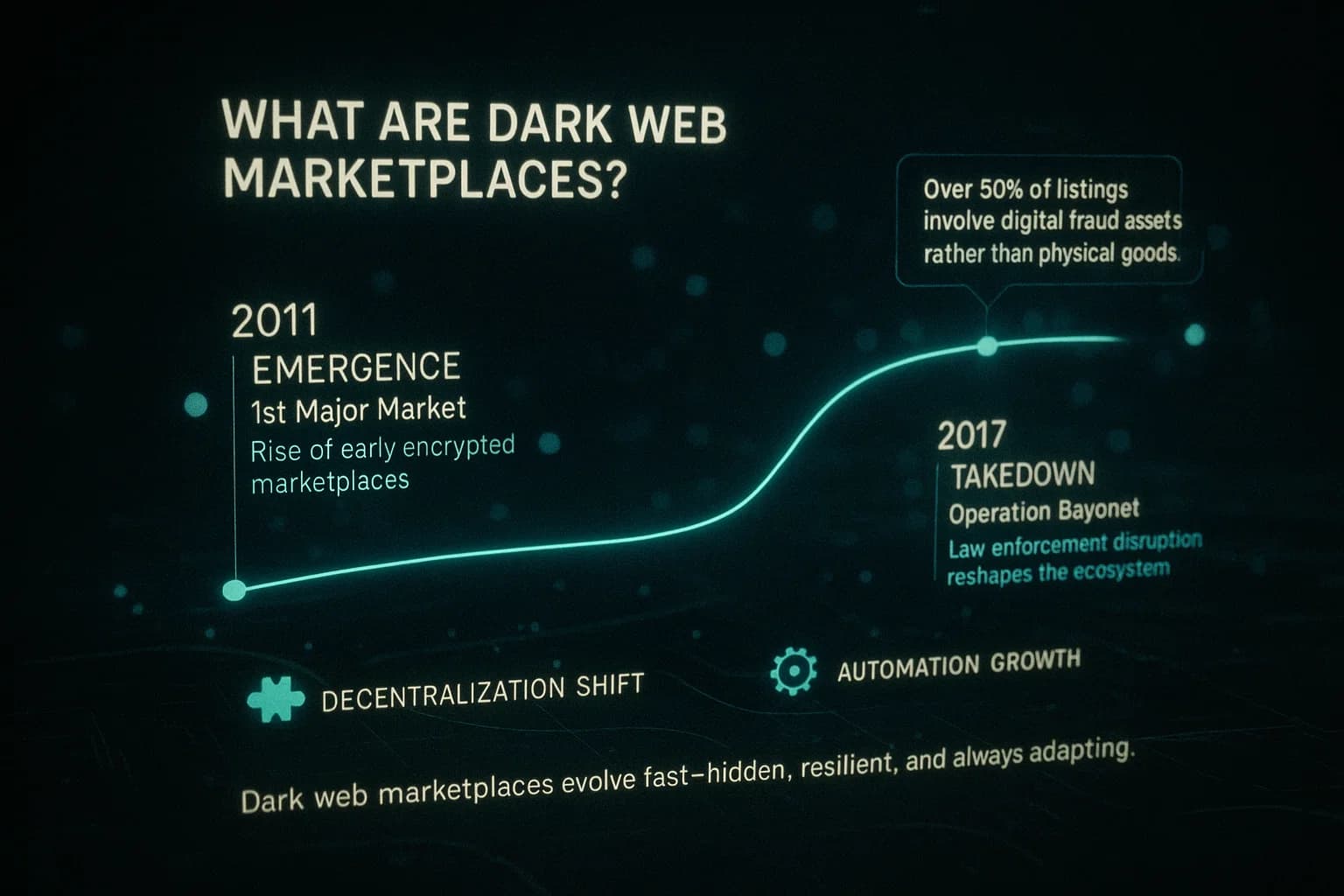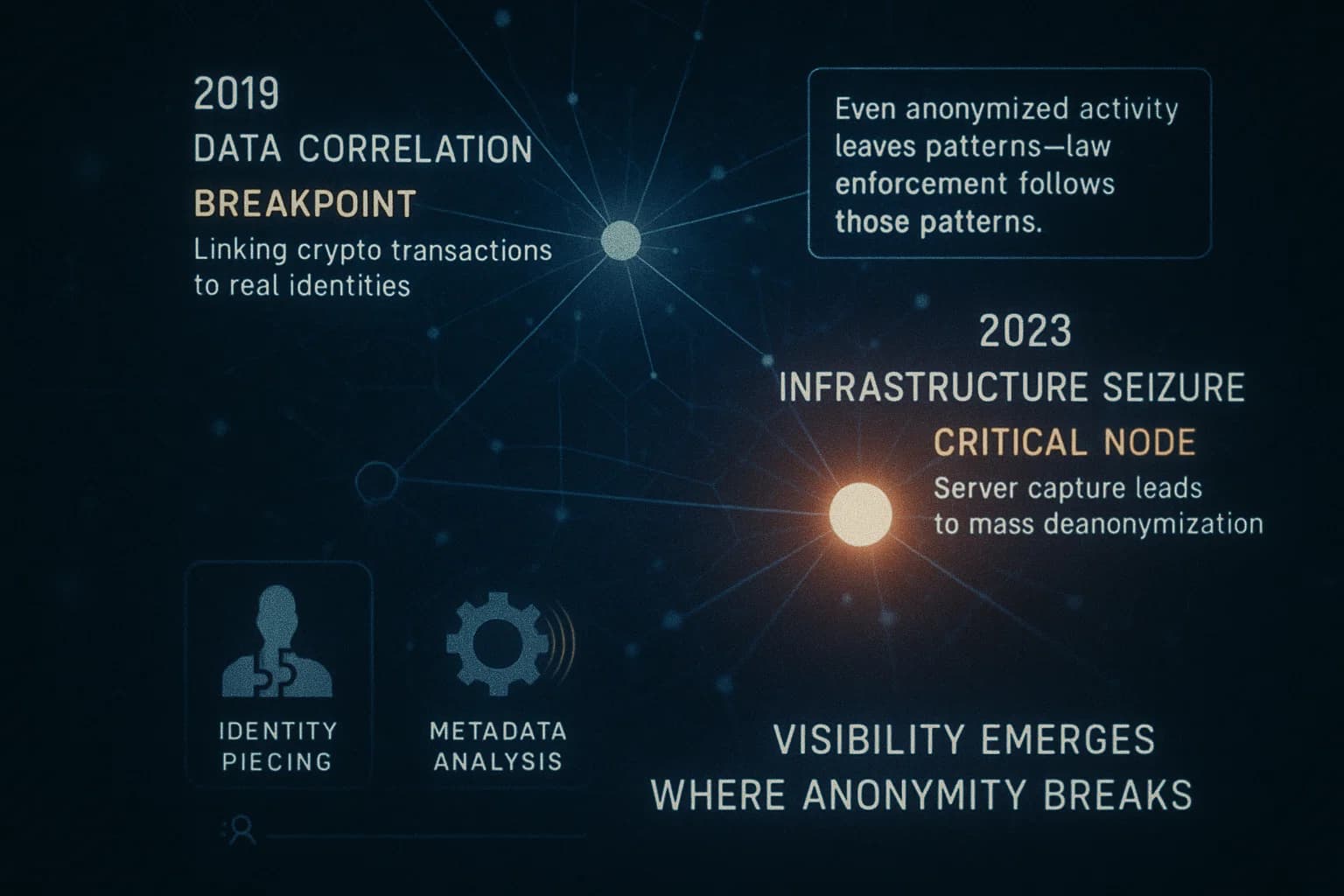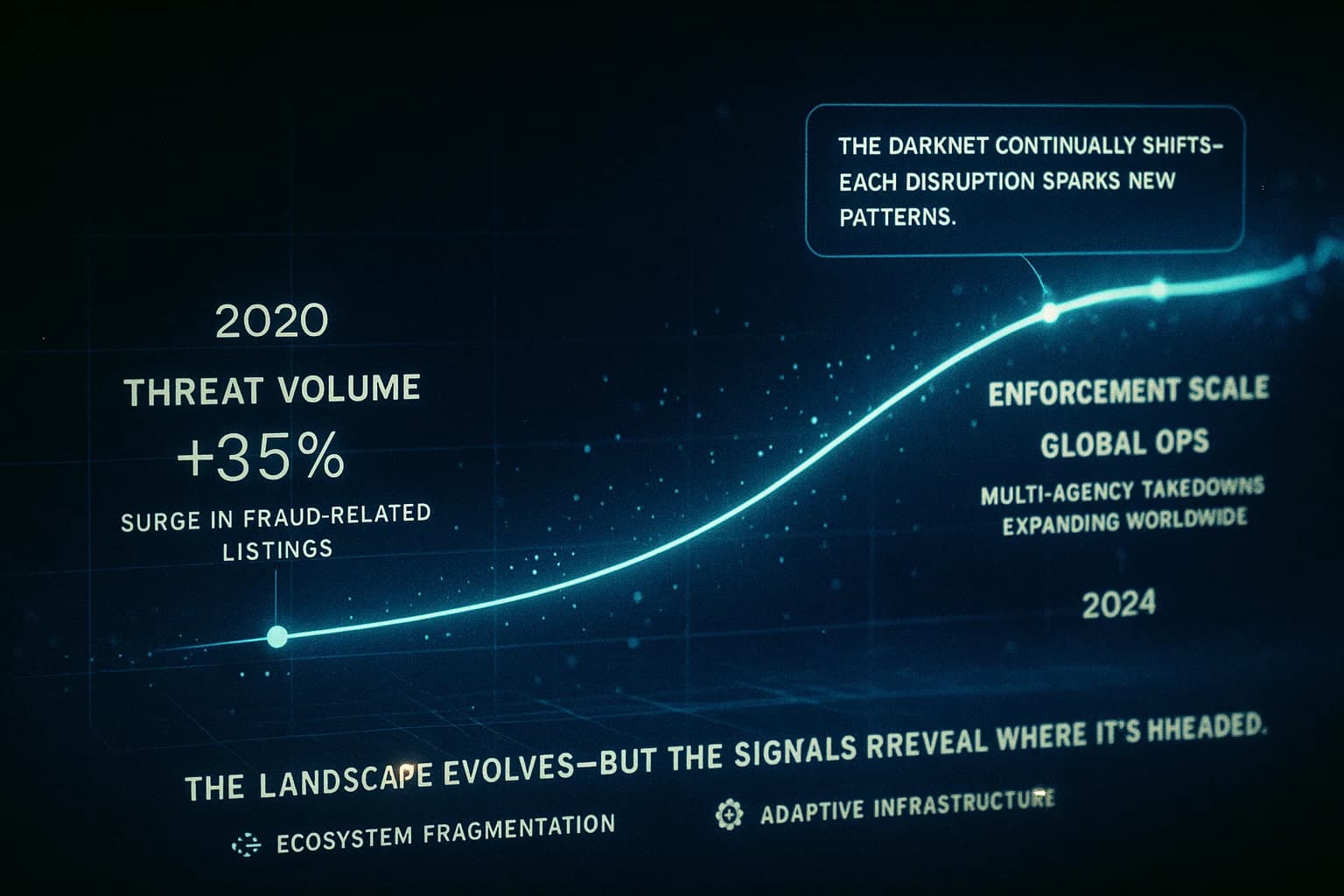November 18, 2025
A detailed look at how global law-enforcement agencies infiltrate, trace, and shut down dark web marketplaces like Silk Road, AlphaBay, Hydra, and Archetyp revealing why anonymity on the dark web is far from guaranteed.
Mohammed Khalil

The dark web hidden internet sites reachable via Tor matters because it hosts illegal marketplaces selling drugs, malware, fake IDs and more fueling global crime. These markets use cryptocurrencies and encryption to hide, but law enforcement’s growing technical skills have repeatedly broken them open. In 2025, understanding these takedowns shows that no dark web market is invulnerable: each bust has foiled large drug networks and undermined the myth that anonymity is guaranteed.

Dark web marketplaces are hidden online bazaars on Tor or similar networks where anonymous vendors sell illicit goods. Unlike the deep web private or unindexed pages, the dark web specifically refers to sites requiring special software Tor to access. These hidden markets promise anonymity, but in practice, users often slip up. For example, the FBI has noted that criminals on Tor routinely reuse usernames or expose device details, allowing investigators to trace them. The dark web is not as dark as you think, warns Europol law enforcement uses specialized techniques to unmask hidden transactions. See our Deep Web vs Dark Web primer for more definitions, and Dark Web Myths vs Reality for common misconceptions.
Despite encryption, these markets leave traces. Every Bitcoin payment is public on the blockchain; every login can leak an IP if misconfigured. By 2025, agencies also use dark web search Engines and honeypots to infiltrate markets. For details, see How Law Enforcement Tracks Criminals On The Dark Web. In practice, authorities combine blockchain forensics, metadata analysis and international raids to dismantle these sites.

Silk Road, launched in early 2011, was the world’s first major Tor based marketplace. It marketed itself as a black market bazaar and sold everything from marijuana to heroin, plus hacking tools and counterfeit IDs. By late 2013 it had 13,000 drug listings and was used by thousands of dealers and over 100,000 buyers. Silk Road built anonymity around Tor and Bitcoin escrow.
Its fall began with a tip to U.S. agents and clever bitcoin tracking. Federal investigators traced Silk Road’s funds on the blockchain, linking them to Ross Ulbricht the Dread Pirate Roberts. In October 2013, a joint FBI DEA IRS task force seized Silk Road’s servers and arrested Ulbricht. Hundreds of kilograms of drugs and millions in Bitcoin were ultimately uncovered. Ulbricht was convicted in 2015; he’s serving life in prison. Silk Road’s demise proved that even Tor hidden sites could be penetrated by good detective work, prompting many users to flee to successor markets.
After Silk Road’s fall, AlphaBay rose in late 2014 as the largest dark web market ever. By 2017 it boasted 200,000+ registered users and 40,000+ vendors, with roughly 250,000 drug listings and 100,000 non drug listings. It sold deadly narcotics fentanyl, heroin, stolen IDs, malware tools, firearms and more. Just as important, AlphaBay’s Bitcoin transactions totaled well over $1 billion. In July 2017 a global law enforcement coalition Operation Bayonet struck. The site’s creator, Alexandre Cazes, was arrested in Thailand on July 5 and later died in custody. By mid July, authorities seized AlphaBay’s servers in Thailand and elsewhere and frozen millions in cryptocurrency.
Simultaneously, Dutch police quietly took over Hansa Market, a Tor site popular in Europe in June 2017. When AlphaBay went offline on July 4, many fleeing users migrated to Hansa which was by then run covertly by police. Law enforcement had modified Hansa’s code to log private messages and even capture passwords and IP addresses. On July 19 20, 2017 the Dutch and Europol publicly announced Hansa’s takedown, having collected data on 10,000 buyer addresses and seized 1,000 BTC in escrow. In effect, Operation Bayonet simultaneously shut down both markets, netting thousands of criminals and shattering community trust. As Europol’s Rob Wainwright noted, users flocked to Hansa expecting refuge, only to be swept up in a trap.
Launched in 2013, Dream Market was a top tier marketplace especially after AlphaBay’s fall. It specialized in narcotics, stolen data credit cards, credentials and contraband. Dream’s peak traffic was in the hundreds of thousands of listings, though exact numbers weren’t made public. Unlike the forceful takedowns above, Dream’s end came quietly: in March 2019 admins announced a shutdown by April 30, 2019. This announcement coincided with Operation SaboTor, a multinational effort targeting opioid vendors. On the same day, the FBI and Europol revealed they’d arrested 61 suspects and seized 50 darknet accounts worldwide. Dozens of Dream Market drug dealers were nabbed e.g. a U.S. heroin syndicate.
The timing suggests Dream’s closure was in response to these raids and perhaps fear of further arrests. Unlike overt seizures, Dream’s shutdown was an exit by administrators, a pattern sometimes seen when market owners bail out. Nevertheless, it underscored that administrators were vulnerable: even long running markets face disruption once law enforcement pressure mounts.
Wall Street Market WSM was a German run Tor marketplace active circa 2016 2019. It supported 5,400 vendors and about 1.15 million customers worldwide. Like others, WSM sold tons of drugs, fake goods and hacking software. On the tech side it used Tor, Bitcoin escrow and forums for buyers/sellers. In April 2019, U.S. and European investigators closed in: German authorities arrested the three young admins ages 23-31. Coincidentally, those admins carried out an exit scam first stealing roughly $11 million in user escrow funds in mid April. The DOJ complaint alleges the admins diverted escrow money to their accounts before vanishing. Shortly after, police in Germany and the U.S. charged the men with narcotics and money laundering.
In other words, Wall Street Market collapsed under its own weight: its leaders chose to steal funds and were then exposed by international law enforcement. Europol called it a double blow to darknet markets. Hundreds of WSM buyers and sellers were later identified and prosecuted. Wall Street’s demise showed that admins can’t escape justice, even if they try a classic exit scam.
By far the largest darknet market by volume was Hydra, launched in late 2015 in Russia. Unlike Western markets, Hydra was Russian language only and became the dominant hub for Eastern European and global cybercrime. At its peak it handled an estimated 80% of all dark web transactions. From 2015 2022 Hydra processed roughly $5.2 billion in crypto. It specialized in narcotics fentanyl, heroin, cocaine, stolen financial data, fake documents, and even in house money laundering/mixing services. Unique to Hydra was its cash out network: converting Bitcoin into Russian rubles via money mules and underground exchange services.
On April 5, 2022, German federal police BKA and U.S. partners struck. Servers were seized in Germany and cryptocurrency wallets frozen 543 BTC, €23M. The alleged infrastructure provider, Dmitry Pavlov 30, a Russian national in Germany, was arrested in Berlin. The U.S. Department of Justice indicted him on major narcotics and money laundering charges. The U.S. Treasury simultaneously hit Hydra with OFAC sanctions. The collapse of Hydra severed a major global drug pipeline. Millions in crypto were recovered, and top Russian vendors and buyers were exposed to investigators. Experts expect the vacuum to be filled by smaller rings, but warned that Hydra’s end proves no market, however entrenched, is untouchable.
Archetyp was Europe’s longest running and bloodiest market in the 2020s. Active from 2020 until June 2025, it amassed 600,000 registered users and 17,000+ listings. Its inventory was almost entirely hard narcotics fentanyl, cocaine, MDMA, amphetamines, making it a key supplier during Europe’s recent opioid and stimulant crises. By 2025 Archetyp had moved roughly €250 290 million worth of drugs and other illicit goods.
Between June 11 13, 2025, Operation Deep Sentinel dismantled Archetyp. German police BKA led a coordinated raid involving Netherlands, Spain, Sweden, Romania and U.S. authorities. They seized Archetyp’s servers in the Netherlands, arrested the alleged 30 year old German admin in Barcelona, and targeted high volume vendors. Authorities confiscated millions in crypto, luxury cars, phones and drugs during simultaneous raids. According to Europol, the operation froze about €7.8 million in assets.
With Archetyp offline announced by Europol on June 23, 2025, Europe lost one of its major fentanyl pipelines just as overdose deaths were surging. Some in the underground forums were fooled by fake posts from a released admin, a likely law enforcement ruse to sow confusion. In any case, the takedown shows that even a market deeply embedded in Europe’s drug trade can be toppled. As Europol’s deputy director put it, the action cuts off a major supply line and signals there’s no safe haven for these crimes.
| Marketplace | Years Active | Scale users/listings | Key Goods Sold | Takedown Agency/Year |
|---|---|---|---|---|
| Silk Road | Jan 2011 Oct 2013 | 1,000s of vendors; 100k buyers | Drugs 13k listings by 2013 + hacking tools, IDs | Seized Oct 2013: Founder Ross Ulbricht arrested by FBI led task force |
| AlphaBay | Dec 2014 Jul 2017 | 40k vendors, 200k+ users | Drugs heroin, fentanyl, stolen IDs, malware, firearms | Seized July 2017 Operation Bayonet: Admin arrested Thailand |
| Hansa Market | 2015 Jul 2017 | 1,700+ vendors, 40k listings | Drugs cocaine, fentanyl, MDMA | Covertly taken June 2017 Dutch police ran it for a month, then shut down July 2017 |
| Dream Market | 2013 Apr 2019 | Tens of thousands of listings | Narcotics, stolen data | Admins shut it down Apr 2019 amid FBI/Europol arrests of vendors |
| Wall Street | 2016 Apr 2019 | 5,400 vendors, 1.15M customers | Drugs, counterfeit goods | Admins exit scam stole $11M in escrow then arrested Apr 2019 |
| Hydra Market | Nov 2015 Apr 2022 | Millions 80% of market volume | Narcotics fentanyl, heroin, stolen data, fake IDs | Seized Apr 5, 2022 German BKA + US: Servers seized, €23M in BTC frozen, key admin indicted |
| Archetyp | 2020 Jun 2025 | 600k+ users, 17k listings | High volume drugs fentanyl, cocaine, MDMA | Seized Jun 11 13, 2025 Op. Deep Sentinel: Servers offline Netherlands, admin arrested Spain |
Each takedown was a cat and mouse operation: markets reappear or fragment after a bust, but their demise always yields valuable intelligence. For instance, Hansa’s police run honeypot netted thousands of user identities, and dream markets collapse still provokes sting operations. These cases make clear that the dark web’s promise of privacy is fragile, especially when vetted by cutting edge crypto tracing and undercover tactics.

Modern darknet investigations rely on a mix of technology and teamwork. Here’s a snapshot of the key steps:
Through these steps, law enforcement can map a marketplace’s structure: the top admins, major vendors and even buyer networks. Once key individuals are identified, coordinated raids and server seizures can be executed. Modern takedowns, like Archetyp’s, often involve dozens of officers across countries e.g. Spain, Germany, Netherlands, Romania swooping in simultaneously. The result: sites go dark, and digital evidence wallet keys, chat logs, images is harvested for prosecutions worldwide.
Of course, criminals adapt. They may hop to smaller markets, switch to privacy coins, or use encrypted messaging. This cat and mouse persists. Dark web takedowns now often involve multiple ops in concert see the how Law Enforcement Tracks Criminals On The Dark Web that orgs use to stay alert. But each bust raises the operational cost and risk for illicit sellers.

Every major market shutdown has ripple effects. Immediately after a big takedown, users flood to remaining markets or spawn new ones a whack a mole cycle. For example, after Silk Road fell, sites like Silk Road 2.0 and Evolution briefly boomed. When AlphaBay disappeared, Hansa and later Dream picked up the slack. Even Hydra’s 2022 fall led to smaller Russian language markets trying to fill the gap, some suspected ones being Abacus or Drughub.
However, these shifts also bring wariness. Vendors now vet markets for trustworthiness, often requiring invites or deposits. Some have moved to decentralized platforms or closed forums. Law enforcement’s success stories also boost dark web monitoring: firms and governments use real time watch services to track stolen data and illicit listings. See our guides on Dark Web Monitoring Tools for how companies watch for leaked info.
Two major themes emerge for 2025:
The common myth that the dark web is a bulletproof black box is busted. When you buy or sell illegal goods online, you are not hidden from law enforcement, Europol’s director emphasized after a Dream Market bust. In practice, no market in the past decade has survived indefinitely. Each collapse netted impressive stats: hundreds of arrests, $millions in cryptocurrency seized, and massive caches of chat logs. These reveal the true scale for example, Hansa’s covert run logged over 38,000 transactions and dozens of thousands of user messages. The takeaway: the dark web’s anonymity has limits, especially against sophisticated investigations.
Dark web marketplaces have come and gone in a long running cat and mouse game. Each takedown from Silk Road to Archetyp has shown that anonymity on Tor is fragile against determined investigators. In 2025, the playing field has tilted even further: blockchain forensics, international cooperation, and covert operations now regularly topple the most notorious markets.
Ready to strengthen your defenses? The threats of 2025 demand more than awareness; they require readiness. If you want to test your organization’s resilience or hunt down hidden vulnerabilities before criminals do, DeepStrike can help.

Explore our Penetration Testing Services to see how we proactively uncover risks in your systems. Drop us a line we’re always ready to dive in.
About the AuthorMohammed Khalil is a Cybersecurity Architect at DeepStrike, specializing in advanced penetration testing and offensive security operations. With certifications including CISSP, OSCP, and OSWE, he has led numerous red team engagements for Fortune 500 companies, focusing on cloud security, application vulnerabilities, and adversary emulation. His work involves dissecting complex attack chains and developing resilient defense strategies for clients in the finance, healthcare, and technology sectors.
Silk Road 2011 2013 was the first major darknet market, selling drugs and illicit goods to 100,000 users. It operated on Tor with Bitcoin escrow. In Oct. 2013, a US led task force FBI/DEA/etc. traced Silk Road’s Bitcoin to its founder Ross Ulbricht, seized the servers, and arrested him. Hundreds of kilograms of drugs and millions in Bitcoin were recovered. This set the legal precedent that even Tor hidden markets are prosecutable.
AlphaBay 2014 2017 was the largest darknet market of its era 200K users. In July 2017 US and international agencies executed Operation Bayonet: they arrested founder Alexandre Cazes in Thailand and seized AlphaBay’s infrastructure. Around the same time, Dutch police had secretly taken over Hansa Market, then shut it down publicly on July 19, 2017. This dual takedown was highly sophisticated: users fleeing AlphaBay’s seizure were tracked on Hansa, yielding thousands of arrests.
Dream Market closed voluntarily in April 2019. Its admins announced the shutdown as authorities FBI, Europol, others were exposing dozens of its vendors in a sting Operation SaboTor. Rather than a violent raid, Dream’s end was essentially an exit by the operators. The timing was not coincidental: the law enforcement crackdown demonstrated that even long standing markets could be infiltrated, so the admins quietly pulled the plug to avoid further fallout.
Hydra 2015 2022 was the largest ever darknet market by transaction volume handling $5.2B. It dominated Russian and Eastern European trade in drugs and stolen data. On Apr 5, 2022, German police with US help seized Hydra’s servers and crypto wallets. This unprecedented coordinated takedown froze millions in Bitcoin and led to indictments of Hydra’s operators. Its fall disrupted a huge part of the global drug trade, showing that even sprawling, language specific markets can be dismantled.
Operation Bayonet was the 2017 joint law enforcement effort that took down AlphaBay and Hansa. Operation Deep Sentinel June 2025 was the Europe led operation that seized Archetyp Market. These operations illustrate the trend: cross border task forces combining agencies FBI, DEA, Europol, Dutch police, etc. targeting multiple markets in one sweep. The takeaway is that big darknet busts now require synchronized international action.
Yes, new and smaller markets persist. After each big bust, entrepreneurs and criminals often re-establish sites. However, they tend to be more fragmented and cautious. Many require invites or vetting, limit their scope, or accept only privacy coins. Law enforcement warns that no site is safe previous markets even the biggest ones have all eventually fallen. Organizations and governments now monitor remaining markets constantly, using Dark Web Monitoring Tools and specialized search engines to stay ahead of these threats.

Stay secure with DeepStrike penetration testing services. Reach out for a quote or customized technical proposal today
Contact Us